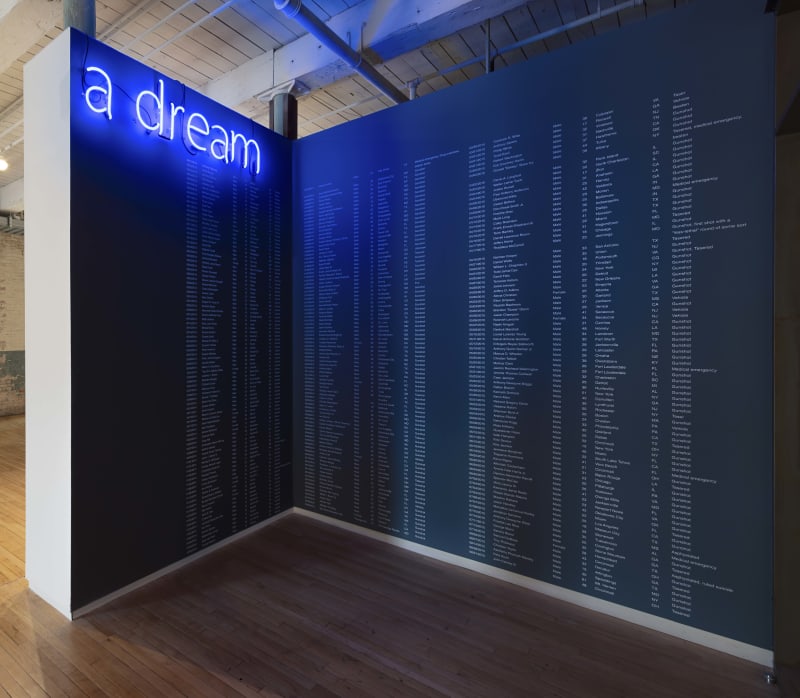The artist nods to James Baldwin with an exhibition that brings to bear the everydayness of racial terror.
NORTH ADAMS — “The Fire Next Time” is, most famously, a slim book published in 1963 that paired two essays by the brilliant writer, poet, and civil rights activist James Baldwin. In the first, “My Dungeon Shook: Letter to My Nephew on the One Hundredth Anniversary of the Emancipation,” Baldwin walks a young man through the pain and tribulation of being Black in America; in the second, “Down at the Cross: Letter from a Region in My Mind,” Baldwin explores the prescriptive dangers of religion and the bias and racism that spring from it. In both, the near totality of darkness is leavened by pinpricks of light. An indignant, impassioned confrontation of racial injustice in America, “The Fire Next Time” is also an exhortation, a plea, and even a vision for a future where hate and intolerance fall to courage and care.
I cannot say I sensed that sprinkle of hope in “the fire next time,” Steve Locke’s newly opened exhibition at Mass MoCA that borrows Baldwin’s title. It is transfixing, a chilling compendium of racially motivated atrocity that remains a constant feature of American life. It offers little respite from the enveloping misery, which I suppose is only fair.
Locke has the numbers to support it. Even before you enter the galleries, you’re confronted with a long list of names, paired with dates, beneath the icy neon glare of a sign that reads “... a dream.” The names, hundreds of them, are a smattering: “A Partial List of Unarmed African-Americans who were Killed By Police or Who Died in Police Custody During My Sabbatical from Massachusetts College of Art and Design, 2014-2015,” is the title, less than a year’s worth of killing. Baldwin’s book was published more than 60 years ago. That’s soul-crushing math to consider.
I know Locke best for his conceptual illuminations, canny and dry, of American racial tension. But “the fire next time” is notably peopled with figurative sculpture and drawing, much of it quietly but incandescently alarming. Inside, the long gallery space is ringed with framed works on broad sheets of paper. Each of them contains a small portrait, drawn in graphite, often in a corner — a small patch of ash-gray in a broad expanse of white. The entry to "Steve Locke: the fire next time," at Mass MoCA. The names on the wall are a catalog of unarmed Black Americans killed by police or who died in police custody during Locke's 2014-15 sabbatical from his professorship at MassArt.
You have to nose up within inches even to see them — Locke’s demand, made plain. Come close, he seems to say. Don’t look away. And up close, you’re face to face with the depths of evil: in stony profile, Dylann Roof, the white supremacist who murdered nine Black people attending bible study at a Charleston, S.C., church; Lawrence Russell Brewer, who was executed in 2011 for dragging a Black man, James Byrd Jr., to death behind his truck in Texas in 1998.
A few of the drawings are of objects — Brewer’s license plate; a memorial sign, shot full of bullet holes, to Emmett Till, a Black teen murdered at 14 years old in 1955 in Mississippi — but almost all are of people, drawn mostly from courtroom photographs or mugshots, or pictures from social media. Till’s murderers, Roy Bryant and his half brother J.W. Milam, are here; so is Bryant’s wife, Carolyn, who alleged Till had harrassed her, sealing his fate. There are dozens, each one a portal to its own particular horror. What they all have in common — race-based hate, and its power to prompt violence — makes this quiet space, with its perimeter of pale images simmering with rage, almost too much to bear.
I stood there a long, long time, as though leaving — ever — somehow made me complicit. Some stories were familiar; many, I’m ashamed to admit, were not. That simple fact made the scope, the magnitude, the everydayness of racial terror in America all the more real. On my phone, I looked up every single one — George Zimmerman, who fatally shot 17-year-old Trayvon Martin, as the teen walked back from a convenience store; Travis and Gregory McMichael, who murdered Ahmaud Arbery during his evening jog in their neighborhood; Gary Thomas Rowe, an FBI informant who admitted to acts of violence against civil rights protestors, including murder, while embedded with the KKK — as though to neglect any was an act of disregard. With extraordinary restraint, Locke simply asks that you take notice; then, noticing is all it takes. With the simplest of gestures, he distills the suffocating weight of racial injustice to unbearable, as it should be. It made for one of the most powerfully affecting contemporary art experiences I’ve ever had.
...

